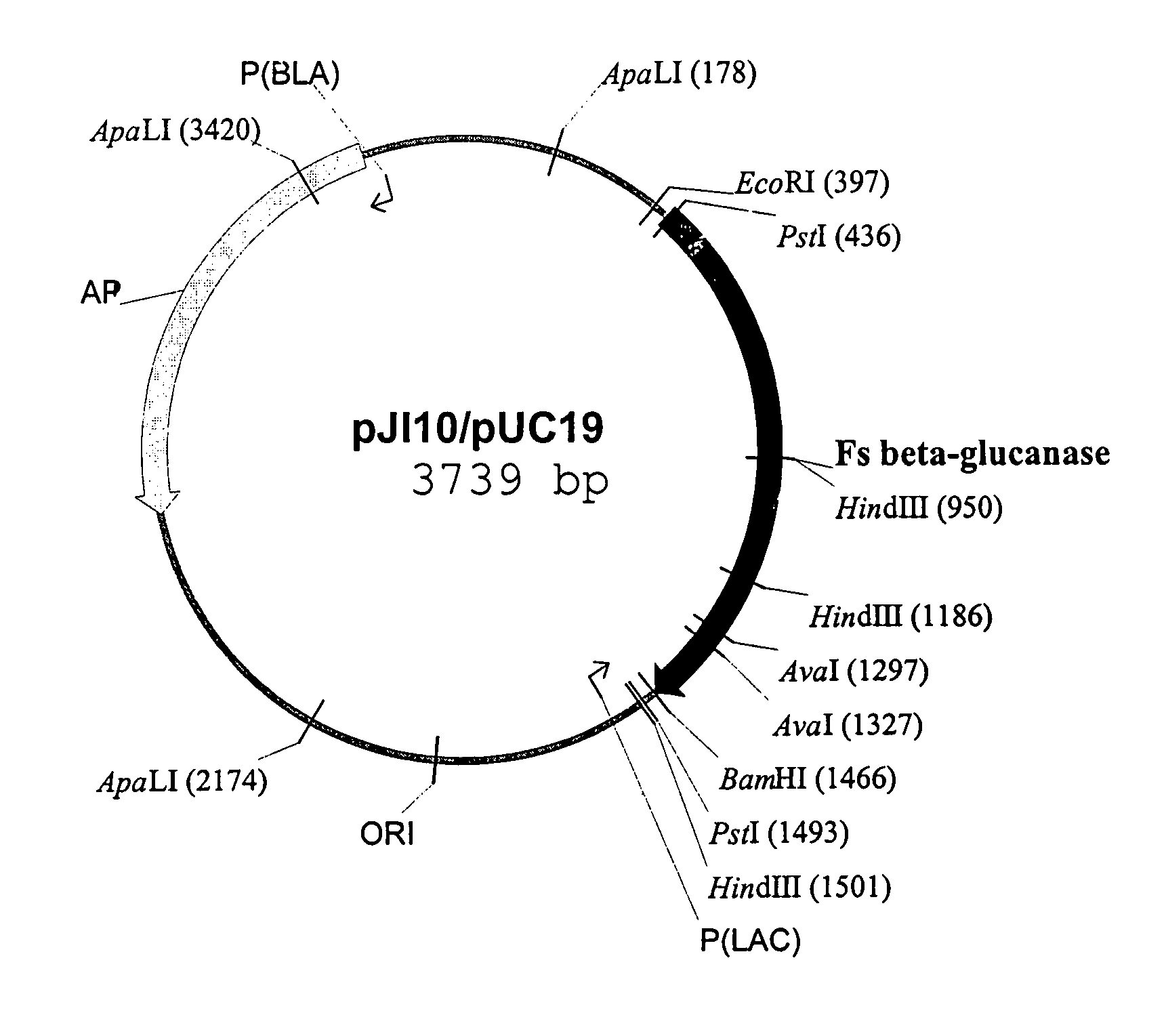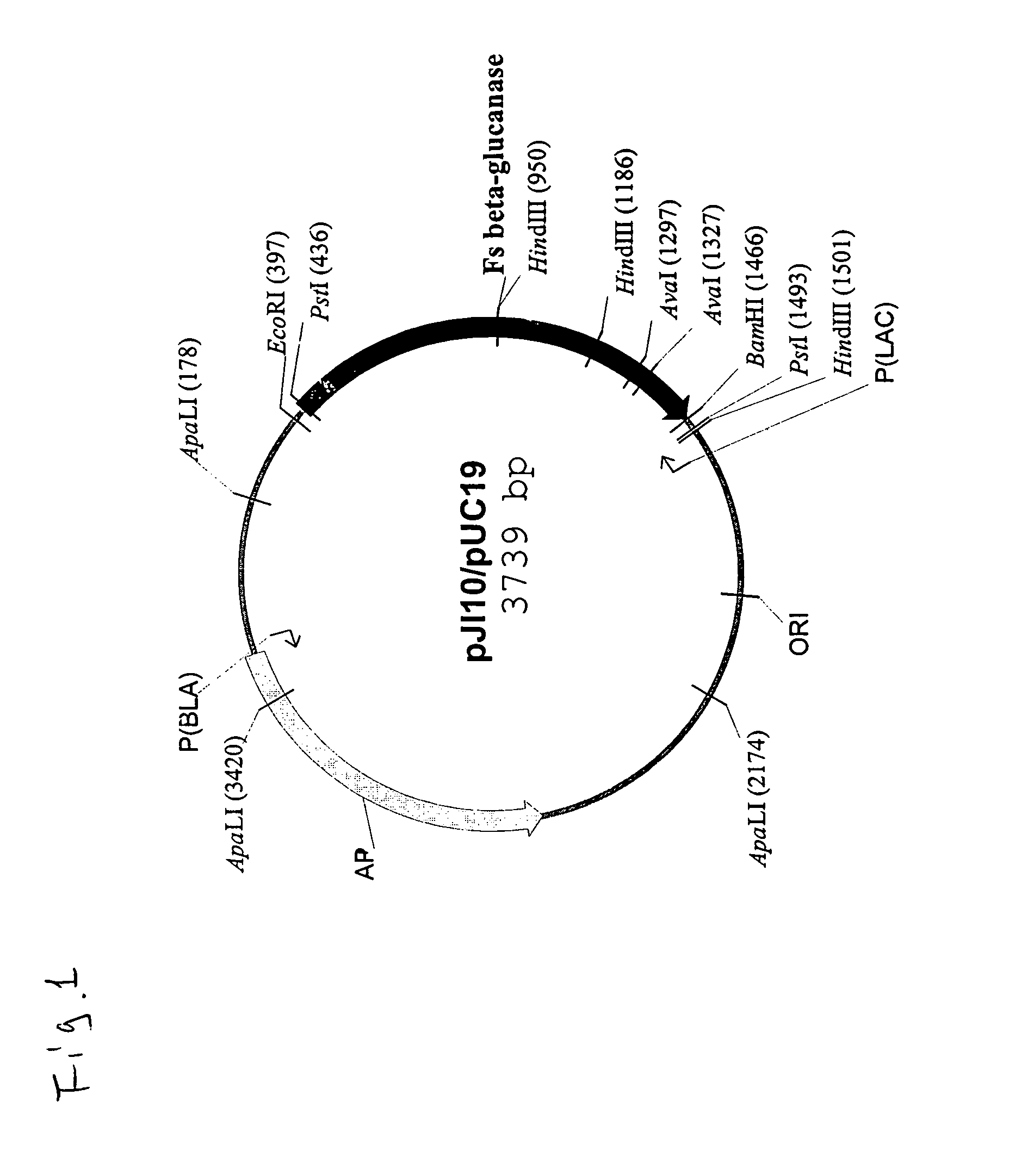Truncated form of fibrobacter succinogenes 1,3-1, 4-β-d-glucanase with improved enzymatic activity and thermo-tolerance
a technology of fibrobacter succinogenes and fibrobacter succinogenes, which is applied in the field of truncated form of 1, 31, 4-dglucanase, can solve the problems of severe inactivation of enzymes, limit of thermal stability of enzymes during industrial processes,
- Summary
- Abstract
- Description
- Claims
- Application Information
AI Technical Summary
Benefits of technology
Problems solved by technology
Method used
Image
Examples
example i
Enzyme Truncation at the DNA Level
Subcloning of Wild-type Glucanase Gene
[0018]pJI10, a plasmid containing a wild-type gene of Fibrobacter succinogenes 1,3-1,4-β-D-glucanase (alse known as Fsβ-glucanase), can be used as a template for the purpose of subcloning the gene, although other DNA templates can also be satisfactorily used as long as they contain the desired glucanase gene. pJI10, whose genetic map is delineated in FIG. 1, is fully described in the prior art by Teather and Erfle in “Cloning and expression of a Bacteriod succinogenes mixed-linkage β-glucanase (1,3-1,4-β-D-glucan 4-glucanohydrolase) gene in Escherichia coli”, Applied and Environmental Microbiology, 54:2672–2676 (1988) and “DNA sequence of a Fibrobacter succinogenes mixed-linkage β-glucanase (1,3-1,4-β-D-glucan 4-glucanohydrolase) gene”, J. Bacteriology, 172:3837–3841 (1990). Thus, it is believed unnecessary to further describe the process of cloning the glucanase gene herein.
[0019]The full-length cDNA of Fsβ-glu...
example ii
Enzyme Truncation at the Protein Level
[0026]The first step in truncating the glucanase at the protein level is to produce the full-length wild type enzyme, which is fully described in the preceding sections in Example I. In summary, E. coli host cells harboring the full length Fsβ-glucanase gene are cultured in either LB, NZCYM, or M9 medium under conditions suitable for cell growth and protein expression. (IPTG may be added at a certain point of the incubation to induce the gene transcription). The active enzyme in the culture medium is then collected (by centrifugation and recovering the supernatant) and concentrated to an appropriate volume on a Pellicon Cassette concentrator (Millipore, USA) with a 10,000 Mr cut-off membrane. The enzyme in the supernatant accounts about 80–85% of total expressed enzyme, and the remaining 15–20% is found in the cell pellet.
[0027]After concentrating the culture supernatant, the second step is to conduct post-expression modification of the protein ...
PUM
| Property | Measurement | Unit |
|---|---|---|
| temperatures | aaaaa | aaaaa |
| molecular weight | aaaaa | aaaaa |
| pH | aaaaa | aaaaa |
Abstract
Description
Claims
Application Information
 Login to View More
Login to View More - R&D
- Intellectual Property
- Life Sciences
- Materials
- Tech Scout
- Unparalleled Data Quality
- Higher Quality Content
- 60% Fewer Hallucinations
Browse by: Latest US Patents, China's latest patents, Technical Efficacy Thesaurus, Application Domain, Technology Topic, Popular Technical Reports.
© 2025 PatSnap. All rights reserved.Legal|Privacy policy|Modern Slavery Act Transparency Statement|Sitemap|About US| Contact US: help@patsnap.com



